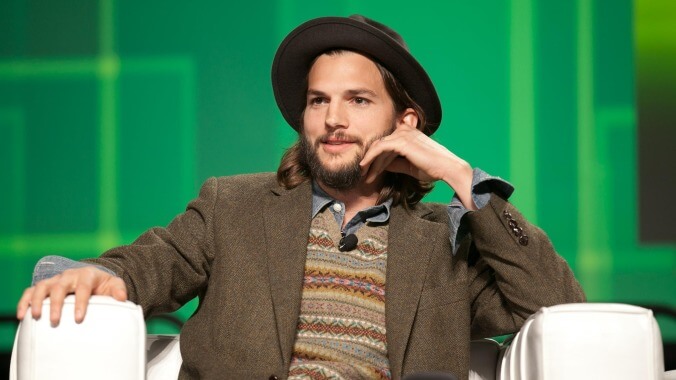Ashton Kutcher at Tech Crunch Disrupt 2011 Photo: JD Lasica/Socialmedia.biz
Only a few months after his NFT-powered animated series was fined $1 million for selling $8 million worth of unregistered images of pot-smoking cats, Ashton Kutcher has found a new tech bubble to enter too late. Kutcher is the latest Hollywood star to shill for the increasingly desperate AI industry. Speaking with former Google CEO Eric Schmidt at the Berggruen Salon in Los Angeles [via Variety], Kutcher praised OpenAI’s latest money pit, Sora, which Kutcher got a beta version of and thinks is “pretty amazing” at generating video.
Kutcher, whose most recent projects include the memorable rom-com, Your Place Or Mine—ironically co-starring fellow AI booster Reese Witherspoon—and writing a letter of leniency for long-time friend, co-worker, and convicted rapist Danny Masterson, is shocked by how quickly one can “create good 10, 15-second videos that look real.” It’s a little more complicated than that.
In April, OpenAI released a one-minute, 20-second short film called Air Head about a man with a balloon for a head. To be clear, it sucks, and its biggest claim to fame is being the rare AI video where a humanoid only has five fingers. More importantly, generating a small amount of video takes a very long time. As explained by tech writer Ed Zitron, Sora takes about 10 to 20 minutes to develop a 3 to 20-second shot, and the user will have no idea what it’s going to produce. They don’t know if the AI will hallucinate or return something that looks bad or, as Zitron points out, has inconsistent balloon-head sizes. But far be it from Kutcher to heap blind praise on a computer program that could probably generate a movie only slightly worse than one starring Kutcher. The actor admits the software “still makes mistakes” and “doesn’t quite understand physics.” Thankfully, physics aren’t a make-or-break factor in looking “real.”
What really shocked Big Kutch was the iterative advancements in these computer-generated establishing shots that are “leaps and bounds” better than one year ago. “In fact, there’s footage in it that I would say you could easily use in a major motion picture or a television show.”
“Why would you go out and shoot an establishing shot of a house in a television show when you could just create the establishing shot for $100? To go out and shoot it would cost you thousands of dollars,” Kutcher asks, as if establishing shots aren’t the foundation upon which most scenes rest. An easy answer is that it looks better to shoot the shot and for the filmmakers to know what they’re getting. But what about “action scenes of me jumping off of this building, you don’t have to have a stunt person go do it, you could just go do it [with AI]”? How about it looks better if a real person does it because AI-generated images look wonky and gross? Also, isn’t art supposed to be about human expression, and why are we posing that question to Ashton Kutcher?
“I didn’t have to hire a CGI department to do it,” Kutcher said roughly 11 months after his union, the Screen Actors Guild, went on strike over this very similar, job-killing hype machine. “I, in five minutes, rendered a video of an ultramarathoner running across the desert being chased by a sandstorm. And it looks exactly like that.” We’ll have to take his word for it, but it sounds thrilling. Move over, The Piano. You and your kind have been replaced by an algorithmically generated cartoon of an ultramarathoner running across the desert being chased by a sandstorm, presumably made of stolen footage of an ultramarathoner, a desert, and a sandstorm.
Like many before him, Kutcher sees a world where “you’ll be able to render a whole movie.” Anyone could come up with an idea, like, say, one about two stoners who don’t know where their car is, and then the computer will write a script and generate a shitty movie no one will watch. Kutcher thinks people don’t like watching “some movie that somebody else came up with,” which is fair if we’re talking about Jobs but less true if we’re talking about Steve Jobs. Kutcher imagines a future where he “can just generate and then watch my own movie” that has nothing to say about life, love, joy, or pain because—and we can’t stress this enough—no computer has ever experienced those things. Well, except for that poor robot that was programmed to feel pain. Why, why was it programmed to feel pain?
“What’s going to happen is there is going to be more content than there are eyeballs on the planet to consume it,” Kutcher continued. “So any one piece of content is only going to be as valuable as you can get people to consume it. And so, thus the catalyzing ‘water cooler’ version of something being good, the bar is going to have to go way up because why are you going to watch my movie when you could just watch your own movie?”
Who are we kidding? AI can’t even make a poster for 12 Angry Men without adding seven extra guys with translucent skin. But what we want to watch is a movie made by a computer, not one by, um, Sidney Lumet. Can this bubble pop already?

